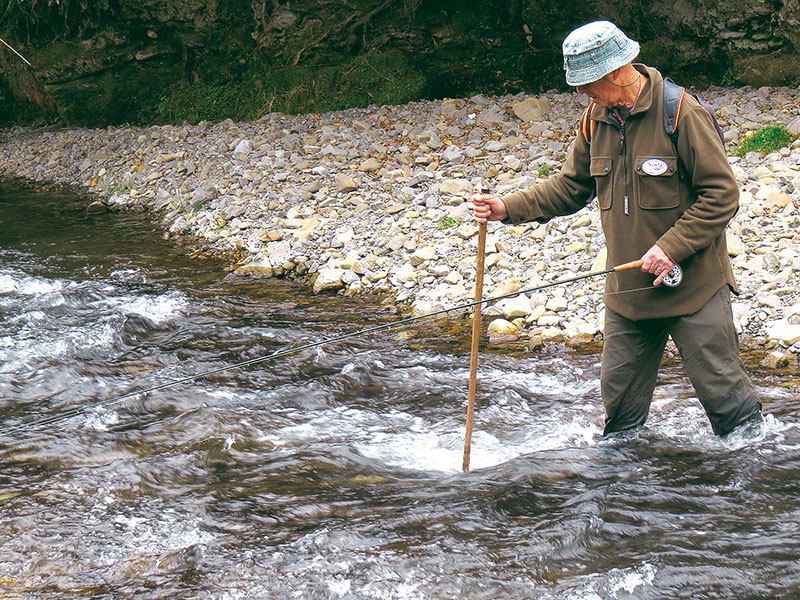A lesson in high-country musterers’ love of nibbie
3 min read
Tony Orman uses a nibbie crossing a bouldery trout stream. Photo: Tony Orman
A nibbie is an essential item for musterers, particularly in the South Island’s mountain country. Talk to high-country sheep musterers of the old days and high-country farmers today – whether they’re teenagers or in the autumn of their years – the nibbie was and still is an indispensable tool. And it should be for hunters and even trout anglers as a wading stick.
The late Lionel Winstanley, a good friend of mine from Marlborough, mustered the region’s backcountry and regarded the nibbie as absolute “essential”.
“It was a good stick for support getting across shingle screes. It was like a third leg in precarious situations such as on screes or crossing a river.”
In earlier decades, nibbies or mustering sticks were a crucial tool to the men who worked the high country on foot.
Notched and sometimes inscribed with the names of stations worked, the wooden nibbie had immense versatility. Like the hikers’ walking pole of today, it was used for balance; in the case of the musterer, it was essential for crossing shingle screes.
It was also of vital importance on a frozen hillside, used on the uphill side to push out and keep one’s feet in a more horizontal position.
Unlike the commercial walking poles of today, the nibbie was multi-functional to musterers.
It was good for taking a boiling billy off the fire, jamming it into the ground for use as a dog tether in a land of few trees, a good stake to tie a dog or two up to, or even hanging a slaughtered sheep up in camp with two men holding the nibbie at each end while the third did the skinning and gutting. They were handmade from a straight length of tough manuka or lancewood.
Nibbies are still used today when mustering cattle, especially around the yards.
I once made a nibbie out of a piece of lancewood that had been felled in a forestry operation. I cut it off to about shoulder height, let it dry, then bored a hole in the top and looped a leather bootstrap through it.
While manuka is good, a hunting-fishing friend reckons willow is as good as any. And why wouldn’t it be? Cricket bats are made from willow.
With both manuka and willow, strip the bark off and it will dry and harden to excellent strength. If you leave the bark on, it won’t take on that ‘hard as nails’ strength.
Today, you can buy some classy light metal ones, including telescopic ones, in outdoor shops.
I’ve found a nibbie ideal in all situations. The musterers found it great on steep scree slopes either on the uphill side or on the downhill side. It’s great going downhill especially if you have a pack load of venison or wild pork on your back; the extra weight and gravity tend to push you down faster than you wish. A nibbie going downhill ahead of you eases the braking strain on the knees. Going uphill, it’s an aid, enabling you to push up and off it.
It’s also handy getting across a fence, pushing the wire, which is often barbed, down while you straddle over it. If the fence is electrified, its non-conducting property is ideal to push the wire down as you step over.
Crossing boulder, backcountry rivers, the nibbie used on the downstream side is a wonderful aid and preventive insurance against taking a dunking and for safety. It’s also ideal for the trout fisher, particularly on high country rivers.



